The 10 best things that happened for Buzzards Bay in 2020
Adversity reveals character, so the saying goes. If so, 2020 certainly presented plenty of opportunities for all of us to demonstrate what we’re made of. At the Buzzards Bay Coalition we were humbled by what was still possible with a broad community of more than 11,000 members and a deep commitment to improving and protecting Buzzards Bay. Despite the challenges that we encountered, we won major victories for clean water.
The effort to Save Buzzards Bay is multi-faceted. It involves ongoing pollution cleanup, focused land protection, active restoration, and community engagement, as you will see in the list below. This year, we made significant progress on every front, thanks to our supporters and partners, and together we will accomplish even more in 2021.
1. Preserving the magic of Cuttyhunk for everyone
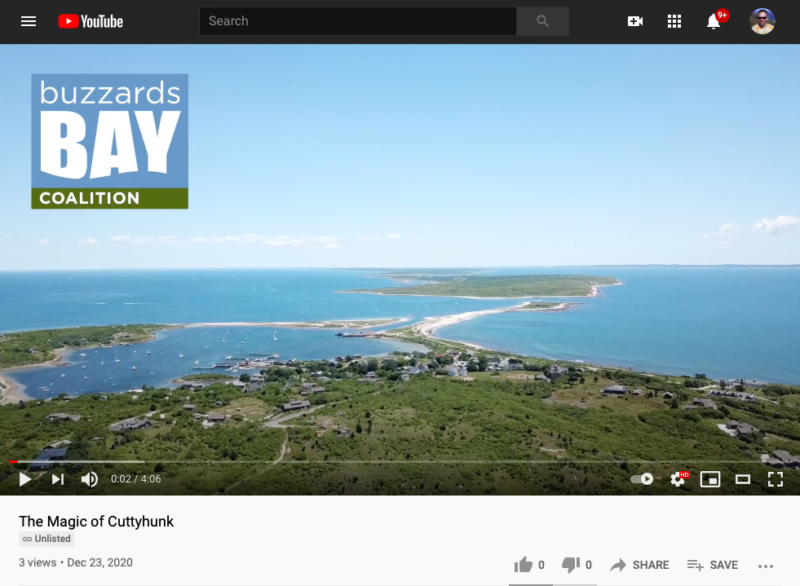
Experience the magic of Cuttyhunk in this video, made possible by Climb High Productions & LandVest, Digital Imaging of Cape Cod, and Edward McCaffrey.
More than anything in 2020, the Coalition’s work to preserve Cuttyhunk Island shows what can be accomplished through perseverance and collaboration. The Buzzards Bay Coalition and its partners—the Town of Gosnold, the Commonwealth of Massachusetts, the United States Fish and Wildlife Service, the Bouchard 120 Oil Spill Natural Resources Damages Trustee Council and 198 private donors—completed a $6.1 million acquisition of 68 acres on the island, much of which had been placed on the market for potential development.
Dramatic barrier beaches, coastal marsh, upland shrub and grassland habitats and the incredible 360-degree views from the tops of the island’s hills will now remain undeveloped, habitat protected for the future and these magical places preserved for public access.
The donation of a conservation restriction on a separate 250-acre property on the island’s west end, which is expected to occur in 2021, will protect more than 5 miles of Massachusetts coastline—nearly all of the island’s remaining large developable property.
2. Protecting lands that protect the Bay
It was a busy year. Working on our own and with our partners, we placed more than 350 acres of valuable woods, wetlands, river and marsh under permanent protection from development throughout the watershed in 2020. That works out to protecting roughly one acre per day. And those acres encompass a range of special places, environmentally-sensitive habitats, and beloved landscapes.
In the spring, the Coalition ensured that the pioneering organic farm Eva’s Garden in South Dartmouth will be protected, both the three-acre working farm that has been so influential in the growth of certified organic agriculture as well as 20 acres of mature woodlands that surround the idyllic property on Jordan Road. The Coalition also protected woodlands on the northern border of Fort Phoenix State Reservation in Fairhaven, one of the Bay’s most popular waterfront parks and the site of the annual Buzzards Bay Swim for 24 years now.
The newly protected lands also include lands vital to the Bay’s health and to ensuring habitat for threatened species. These include Westport woodlands that contain two of the few remaining coldwater streams in Massachusetts—Angeline and Lyons brooks. Those streams provide much needed spawning ground for sea run Eastern Brook Trout; the 50-acre Lyons Brook property will open in 2021 as a public reserve with walking trails. Similarly, the 220-acre expanse of woods and wetlands in Rochester acquired this fall is home to threatened species, such as the Eastern Box Turtle, and sits at the headwaters of the Sippican River.
3. Modeling a better future in West Falmouth Harbor
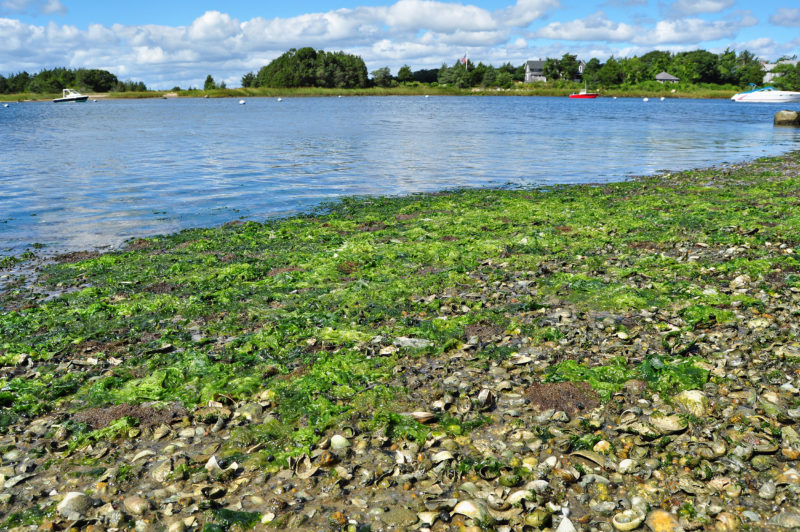
Nitrogen pollution fuels the growth of algae, which can wash up on beaches as slimy green muck.
This summer, the Coalition completed a four-year effort to install 30 nitrogen-reducing septic systems along the shore of West Falmouth Harbor. This is critical work. Nitrogen pollution represents the biggest, long-term threat to Buzzards Bay and residential septic systems are the single largest source of the problem. Nitrogen-removing systems could make a huge difference in places like West Falmouth Harbor, which has struggled for decades with nitrogen pollution.
Early data show that the project has been an enormous success. The newly-installed systems are performing well, removing more than 70 percent of the nitrogen that would have flowed into West Falmouth Harbor. Even better, the positive results there are inspiring others to take an interest in these septic systems (see #4).
4. Marion and Westport take the lead to reduce pollution
One way to address the widespread threat of nitrogen pollution is to be sure not to repeat the mistakes of the past. Two Bay towns joined a small but growing number of municipalities that require all new construction to use nitrogen-reducing septic systems. Wareham and Tisbury already have similar requirements in place.
While requiring nitrogen-reducing systems for new construction doesn’t remove the pollution being contributed by existing systems, it does help to limit the growth of new sources of nitrogen flowing to Bay waters. That’s good news for eelgrass, shellfish, and other marine plants and animals that are endangered by nitrogen pollution, as well as for everyone who lives near and loves the Bay.
This type of regulation particularly matters in towns like Westport, where property owners rely exclusively or largely on septic systems.
5. Saving salt marshes with science
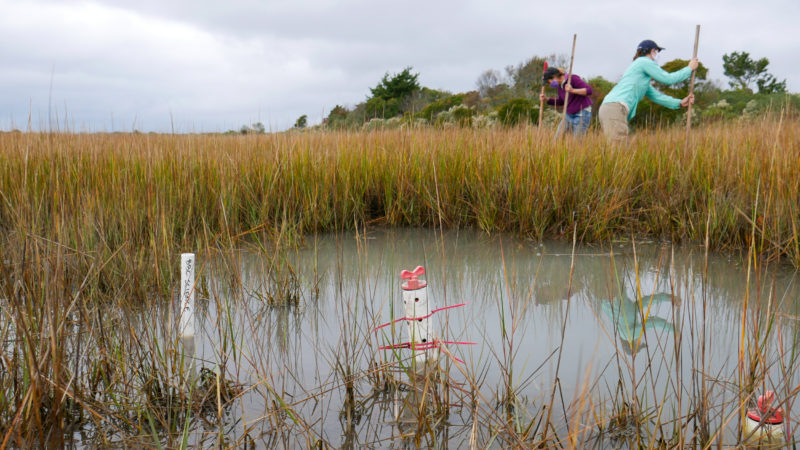
An area of impounded water on the salt marsh at Ocean View Farm, where the Coalition is testing a method to drain these “die back” areas and allow vegetation to grow back.
Between nitrogen pollution and sea level rise, salt marshes are declining at an alarming rate all around Buzzards Bay. It’s a problem that we began examining more closely in 2017, first in the West Branch of the Westport River. This year, we launched a major effort to test a method for arresting the troubling loss of salt marshes.
The technique that is being tested in South Dartmouth and Fairhaven aims to drain standing pools of salt water trapped on the interior of a salt marsh by increasingly high tides, helping the habitat’s plants to flourish. When saltwater remains in pools on the marsh, it kills the vegetation on the interior, which is adapted to grow in dry conditions at low tide. Over time, these “die back” areas expand, eating the salt marsh from the inside out. In addition, these areas of impounded water create mosquito breeding habitat that can pose public health threats.
The initial work was completed in November and monitoring has begun to determine the extent to which this approach can help mitigate salt marsh decline. At the same time, we are continuing with a broader, long-term study of salt marshes around the Bay to better understand their decline and strategies for saving these vital habitats.
6. Rolling on to victory together, at a distance
Despite all the challenges presented by the pandemic, roughly 265 cyclists pedaled the South Coast to show their support for clean water on a beautiful fall day in early October. The 14th annual Buzzards Bay Watershed Ride brought 291 registered participants and 58 volunteers together to raise more than $215,000 to protect Buzzards Bay.
To be sure, this year’s event was unique. The ride began at Sakonnet Point with a rolling start to spread cyclists out; the route itself was different and shorter, ending at Fort Taber Park in New Bedford; and there was no finish line party. Still, it was a great success with the broad community support evident as cyclists rolled through the finish line all afternoon, celebrating their ride along the Bay and the funds they raised to protect it for the future.
7. Overcoming barriers to monitor the Bay
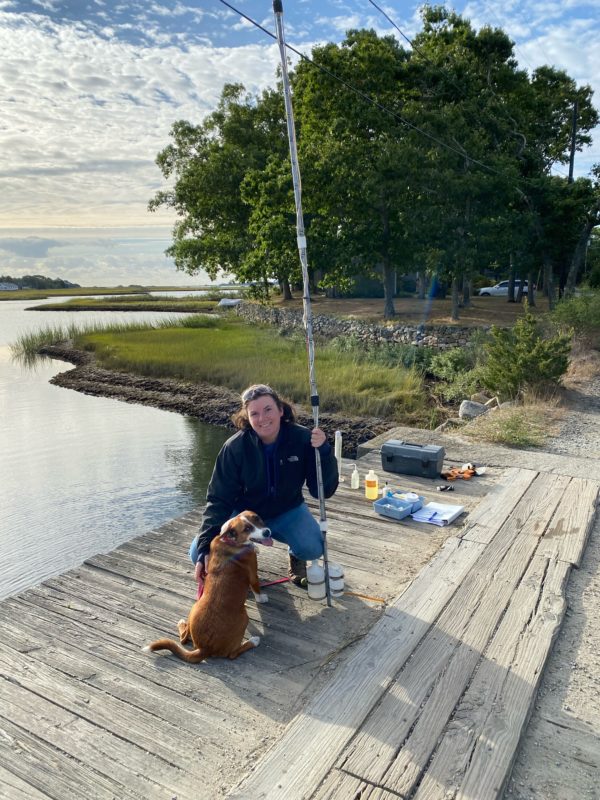
Tori Frew and her friend get out early to collect samples for the Baywatcher water quality monitoring program.
The Baywatchers water quality monitoring program finished the 2020 monitoring season without missing a beat, collecting samples throughout the summer at 200 locations around Buzzards Bay. It’s a remarkable outcome considering the fact that this year’s effort began during a statewide lockdown to control the spread of the coronavirus. But the commitment of our 164 trained volunteers and of partners like the Marine Biological Laboratory to adapt got the job done.
This is great news for the entire Bay. The water quality monitoring program, which is now in its 29th season, creates a foundation to guide Bay protection efforts by the Coalition, local municipalities, state and federal agencies and local land trusts. The data collected through the program also produces the Bay Health Index, which scores the health of harbors and coves, from 0 to 100. And just this month, the MA Legislature approved $50,000 for this work to continue in 2021. Special thanks to Senators Mark Montigny, Michael Rodrigues, Susan Moran and Representative Antonio Cabral!
8. Restoring the Weweantic River to flow free once more
The Coalition realized an historic win for the Weweantic River and the Bay this year: the removal of a crumbling dam at Horseshoe Mill that had impeded migratory fish from swimming upstream for centuries.
The dam’s removal has allowed the river to establish a natural course through the former industrial site and it has created space for native plants to re-establish themselves. And the Coalition has worked to ready the reserve to welcome back visitors in 2021, improving trails on the reserve, repairing the bridge over the Weweantic, installing interpretive signage and canoe launches, among other things.
The river has been home to the most diverse community of migratory fish, despite the dam. Now, species such as herring, white perch, and rainbow smelt will have more than three miles of upstream habitat in which to breed. The restored habitat along its banks will create new space for native plants and animals. And human visitors will find a vibrant natural reserve for walking, paddling and enjoying the outdoors.
9. Discovering adventure in Onset Bay
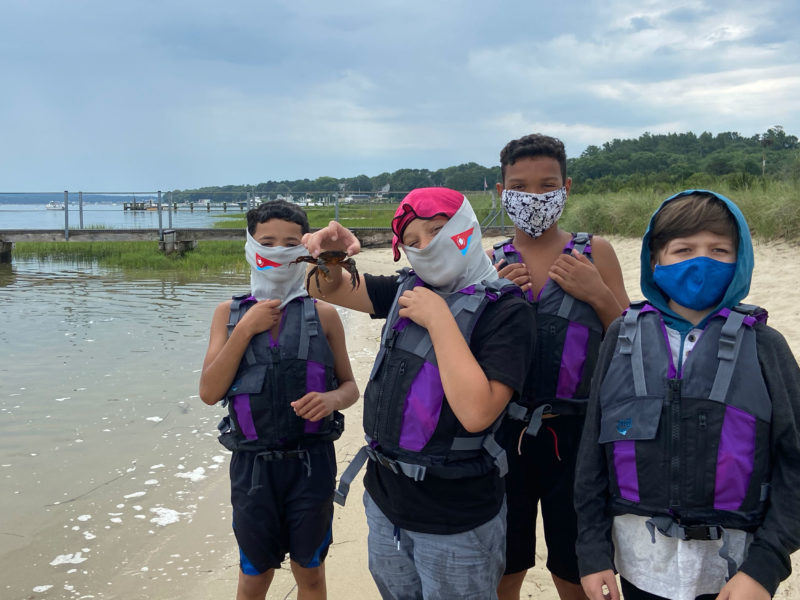 Over the course of the summer and throughout the fall, the Coalition served hundreds of children and adults with a vibrant array of programs at the Onset Bay Center, anchored by the newly renovated Onset Bathhouse that serves as its headquarters.
Over the course of the summer and throughout the fall, the Coalition served hundreds of children and adults with a vibrant array of programs at the Onset Bay Center, anchored by the newly renovated Onset Bathhouse that serves as its headquarters.
The 18-month, $3.2 million renovation of the bathhouse was completed in June, and we immediately began running outdoor programs at Onset Bay Center—paddling, shellfishing, rowing, yoga sessions on the beach and on Wickets Island, and shoreline ecology programs. The response from the community has been enthusiastic, and the Center has strengthened its partnerships with local organizations, such as the Wareham Boys and Girls Club and the Beyond School Time office of Wareham Public Schools.
The pandemic may have forced us to change some of our plans, such as offering sailing instruction this year, the creativity of our staff more than demonstrated the impact that we can have in introducing Bay adventures to more people. Already, plans are underway for next summer at Onset Bay Center, where we can draw on a complex of scenic, diverse protected lands at Wickets Island, Burgess Point, and Shell Point Marshes for the center’s on-the-water programming.
10. Defending the Bay’s oil spill prevention rules (again)
Protecting Buzzards Bay is an effort that requires perseverance. The Bay’s hallmark protection against oil spills was under attack again by the oil industry, and the Coalition partnered with the Massachusetts State Attorney General to defeat yet another effort to weaken the regulations that require tugboat escorts for all barges carrying oil through Buzzards Bay.
The court victory, which came in January, marks the fourth straight win for the Bay’s protection in little more than a decade. Ever since the Massachusetts Oil Spill Prevention Act (MOSPA) was put in place, the oil industry has sought to overturn it. They lost again, this time in federal district court.
MOSPA was enacted in 2004 in response to the Bouchard 120 oil spill in Buzzards Bay. In response to the disaster, the Coalition led the successful effort to draft and win passage of the state law. It’s protection that is sorely needed. More than 2 billion gallons of oil pass through Buzzards Bay each year. The tugboat escort requirement has prevented oil spills in the more than 15 years it has been in place. We plan to keep it that way.